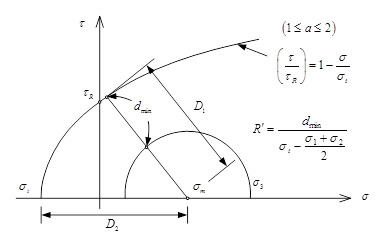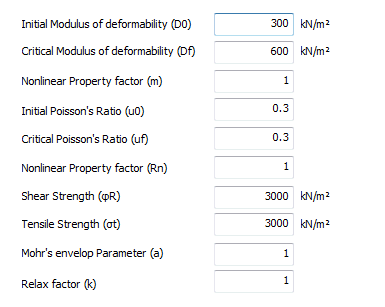|
The D-min model is a secti1d linear model proposed by Japan Central Research Institute of Electric Power Industry (CRIEPI), Hayashi, Hibino and applied to general rocks (hard rock, soft rock etc.). In this model, the stiffness is different for each construction step, but the stiffness within 1 construction step is a constant value. In other words, the materials in the model have a fixed material property value for each load step and hence, do not require repeated analysis.
It is assumed that as the failure envelope approaches the Mohr circle, the interior bonding state of the rock eases and the Elasticity modulus decreases while the Poisson’s ratio increases. Hence, the relative distance between the Mohr circle and failure envelope in each section determines the Elasticity modulus and Poisson’s ratio.

<Failure envelope and Mohr circle of D-min model>
The main nonlinear parameters are as follows.

If the user enters the material properties at the initial state and limit state, the value proceeds to the limit state material property depending on the plasticity as shown below.

Here,  is the initial Elasticity modulus, is the initial Elasticity modulus,  is the limit Elasticity modulus, is the limit Elasticity modulus,  is the nonlinear property factor, is the nonlinear property factor,  is the initial Poisson’s ratio, is the initial Poisson’s ratio,  is the limit Poisson’s ratio, is the limit Poisson’s ratio,  is the nonlinear material modulus. is the nonlinear material modulus.
The Mohr’s envelop parameter ( ) and relax factor ( ) and relax factor ( ) increases with the increase in initial Elasticity modulus ( ) increases with the increase in initial Elasticity modulus ( ).The relationship between the Mohr’s envelop parameter ( ).The relationship between the Mohr’s envelop parameter (  ) and relax factor ( ) and relax factor ( ) with the initial Elasticity modulus ( ) with the initial Elasticity modulus ( ) is shown below. The data was based on the triaxial compression test and put together ) is shown below. The data was based on the triaxial compression test and put together
|
Initial Elasticity modulus ( , , ) )
|
Relax Factor ( ) )
|
Mohr’s envelop parameter( ) )
|
|

|
2.0
|
1.0
|
|

|
4.0
|
2.0
|
|

|
6.0
|
3.0
|
|

|
10.0
|
4.0
|
<Table. Parameters based on initial Elasticity modulus (JARTIC, 1986)>
|
